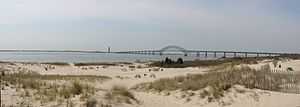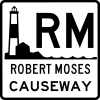Robert Moses Causeway
| |
|---|---|
 Map of Suffolk County on Long Island with Robert Moses Causeway highlighted in red | |
| Route information | |
| Length: | 8.10 mi[1] (13.04 km) |
| Existed: | 1951[citation needed] – present |
| History: | Completed in 1964[citation needed] |
| Major junctions | |
| South end: | Robert Moses State Park on Fire Island |
|
| |
| North end: |
|
| Location | |
| Counties: | Suffolk |
| Highway system | |
The Robert Moses Causeway is an 8.10-mile (13.04 km)-long parkway in Suffolk County, New York, in the United States. The parkway, originally known as the Captree Causeway, connects West Islip on Long Island to the barrier beach islands, such as Captree Island, Jones Beach Island, and the western tip of Fire Island, to the south. It is designated New York State Route 908J (NY 908J), an unsigned reference route. The road, like most parkways in New York State, is limited to non-commercial traffic, except south of NY 27A.
Route description

The Robert Moses Causeway begins inside Robert Moses State Park, located on the western tip of Fire Island. From here, the highway heads north across the Fire Island Inlet on the Fire Island Inlet Bridge. On the north side of the inlet, the road changes from a two-lane undivided highway into a four-lane undivided highway as it enters Captree State Park and approaches a cloverleaf interchange with Ocean Parkway. The parkway becomes a five-lane divided highway with three northbound lanes and two southbound lanes in the vicinity of the junction.[2]
The parkway then traverses the State Boat Channel Bridge by way of a 665-foot (203 m)-long bascule bridge modeled after the Mill Basin Drawbridge in Mill Basin, Brooklyn. The north foot of the bridge contains an unnumbered interchange to a private road on Captree Island, where the rest of the road is surrounded by protected land. On the section that crosses over the Great South Bay, via the Great South Bay Bridge, the New York City skyline can be faintly seen on a clear day. Originally a toll bridge, the remnants of the former toll plaza for the Great South Bay Bridge can be found on the north side in West Islip. At the cloverleaf interchange with NY 27A, the third northbound lane becomes the deceleration ramp, and from there the rest of the parkway is four lanes wide.[2]
The parkway soon takes a slight northeastern turn and later rises to move over Union Boulevard (County Route 50 or CR 50), the Montauk Branch of the Long Island Rail Road, and Orinoco Drive with no access to either roads. Instead, another cloverleaf interchange is available at NY 27. The road remains elevated as it crosses over Muncey Road, and then runs along the west side of Casamento Park, before approaching its northern terminus at the interchange with the Southern State Parkway. The north-to-eastbound ramp to the Southern State and Heckscher State parkways contains an interchange of its own with CR 57 (Bay Shore Road). The other ramps exist on a partial cloverleaf just west of Bay Shore Road's interchange with the Southern State.[2]
History
The first sprawling trestle crossing from West Islip to Captree Island was completed in 1951. The structure is 3,206.2 metres (2.0 mi) in length with a middle clearance for boats of 18.2 metres (59.7 ft).[3] Originally, one lane was for southbound traffic and the other for northbound traffic. In 1967, a new span was built next to the original bridge, carrying three lanes of northbound traffic.[3] The original bridge was reconfigured to carry southbound traffic.
The Fire Island Inlet span was completed in 1964 and by 1985 a dual span was supposed to be built in order to alleviate traffic, but it was never done. When first proposed in 1938, the span was to be a vertical-lift span with a design similar to that of the Marine Parkway-Gil Hodges Memorial Bridge. Later, the design of the Fire Island Bridge was changed to conform with that of the Great South Bay span, a 600-foot (180 m) steel-arch span with a 60-foot (18 m) clearance.[4][5]
Future
In 2004 the New York State Department of Transportation began studies on the Fire Island Inlet span due to flaws in the cement used for its construction. Currently repairs are being undertaken to extend the life and safety of the bridge. These repairs—groundbreaking for a new bridge—were expected to be finished in 2010.[citation needed] It is assumed that the new bridge will be built to the west of the current structure; the new span will be four lanes, two southbound and two northbound.[citation needed] The new bridge is expected to retain the look of the old one, for aesthetic conformity with the other bridges of the bay.[citation needed] After the new bridge is constructed, the original span will be removed. Implosion is not thought to be the best method of deconstruction. Instead it is more likely the bridge will be disassembled and removed by crane.
Exit list
The entire route is in Suffolk County.
| Location | Mile[1] | km | Exit | Destinations | Notes |
|---|---|---|---|---|---|
| Fire Island | 0.00 | 0.00 | Robert Moses State Park | Traffic circle | |
| Captree State Park | 1.03 | 1.66 | |||
| Captree Island | Exit contains ramps for reversing direction on the Causeway | ||||
| West Islip/Bay Shore | 5.25 | 8.45 | Signed as RM2 E (east) and RM2 W (west) | ||
| 7.32 | 11.78 | Signed as RM1 E (east) and RM1 W (west); all northbound trucks and buses must exit | |||
| 8.10 | 13.04 | Northbound exit and southbound entrance | |||
| Northbound exit and entrance, from north to eastbound ramp to Heckscher and Sagtikos State Parkways | |||||
| Northbound exit and southbound entrance | |||||
| 1.000 mi = 1.609 km; 1.000 km = 0.621 mi | |||||
See also
.svg.png) New York Roads portal
New York Roads portal
References
- ↑ 1.0 1.1 "2007 Traffic Data Report for New York State" (PDF). New York State Department of Transportation. July 25, 2008. Retrieved July 17, 2009.
- ↑ 2.0 2.1 2.2 Microsoft. "overview map of the Robert Moses Causeway". Bing Maps (Map). Cartography by Nokia. http://binged.it/100IzSH. Retrieved January 4, 2013.
- ↑ 3.0 3.1 National Bridge Inventory, a database compiled by the United States Department of Transportation Federal Highway Administration, available at www.nationalbridges.com. Accessed August 29, 2007.
- ↑ Maiorana, Ronald (June 14, 1964). "New L.I. Bridge Opened By Moses". The New York Times. p. 82. Retrieved April 11, 2010.
- ↑ Anderson, Steve. "Robert Moses Causeway". NYCRoads. Retrieved April 11, 2010.
External links
Route map: Google / Bing| KML file (edit) |
| Wikimedia Commons has media related to Robert Moses Causeway. |
- Robert Moses Causeway at Alps' Roads • New York State Highway Termini
- Robert Moses Causeway Article from NYCROADS Web Site
- Interchange of the Week; Monday, March 19, 2001 (Empire State Roads)
- Captree State Park
- Robert Moses State Park
- Robert Moses Causeway (Greater New York Roads)
| |||||||||||
